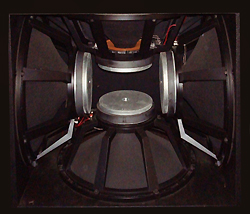While we tend to think of extended bass as a modern invention, audio folks have been expanding frequency response for decades. Way back in 1932, A.C. Thuras received a patent for a bass reflex ported design, and in 1934, Andre D’Alton was granted a patent for a bandpass design.
However, true separate subwoofers (dedicated band-limited enclosures with cone loudspeakers for frequencies generally below 100 Hz) did not become commonplace until the 1960s, and even then were mainly used in limited applications like organs or for special effects.
My first experience with a dedicated subwoofer was the 1974 disaster movie “Earthquake,” which used a technology called “Sensurround” where multiple subs were placed around the theater to provide the audience with the sound and feel of the rumble of an earthquake.
By the late 1970s, popular music featured more low end, with subs becoming common at concerts and events. The longstanding approach was to place the subs (usually omnidirectional pattern boxes) in two stacks, one on each side of the stage. This configuration gave rise to a phenomenon most often termed the “power alley,” as the bass response was noticeable louder in the middle of the audience area where the two stacks combined.
As knowledge of physics and acoustics has increased, we now see all sorts of sub deployments. Popular approaches include flying them alongside, above, or behind the mains, ground stacking them under the mains, and lining them across the front of the stage.
The palette of configurations has also grown. A cardioid configuration has a group of subs with one or more cabinets facing the rear, while the rear subs have their signal polarity reversed and time alignment is applied to cancel sound waves at the rear. An end-fired array configuration has a group of subs in a line with space between them, and with the addition of time alignment, sound can be directed in a specific direction.
Enclosure designs are also far more varied. Manufacturers now offer cabinet styles such as horn loaded, bass reflex, bandpass, and even cardioid, available in both powered and unpowered versions. Some even combine different designs in hybrid boxes.
Regardless of what design is used, or how they’re deployed array, the addition of one or more subs results in a system with more thump. And that’s usually a good thing. Enjoy this Real World Gear Roundup of a wide range of current models.
Senior contributing editor Craig Leerman is the owner of Tech Works, a production company based in Las Vegas.















